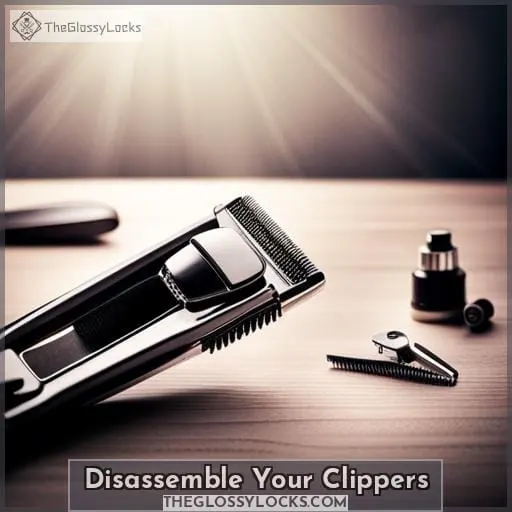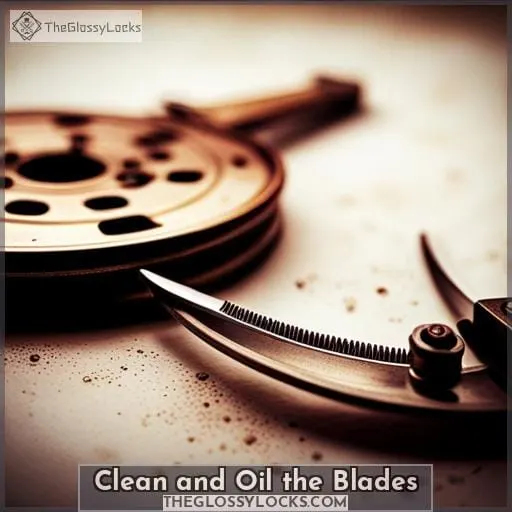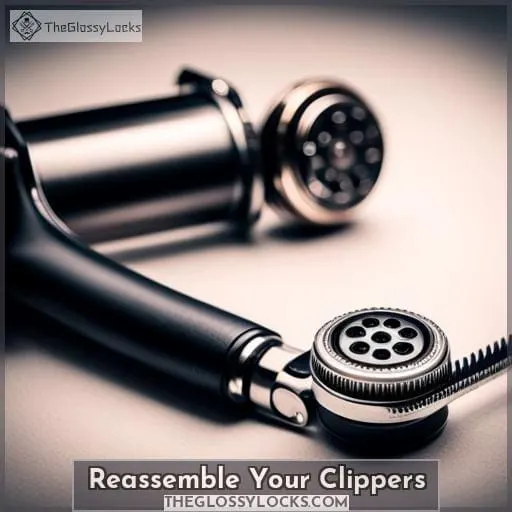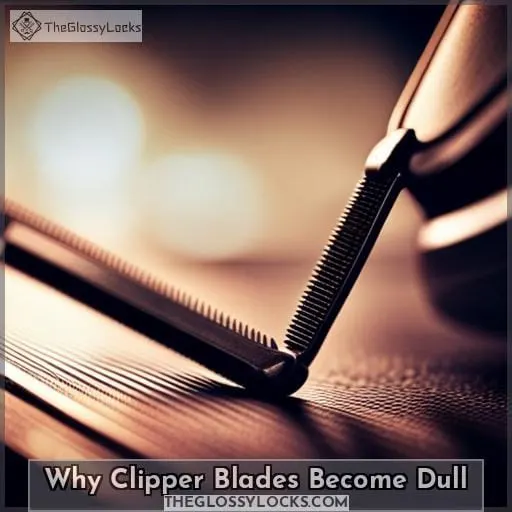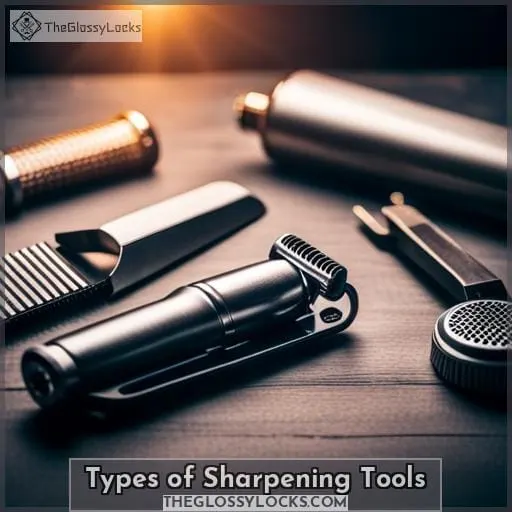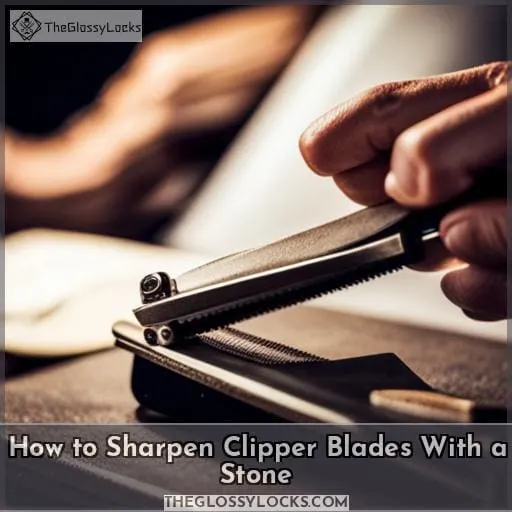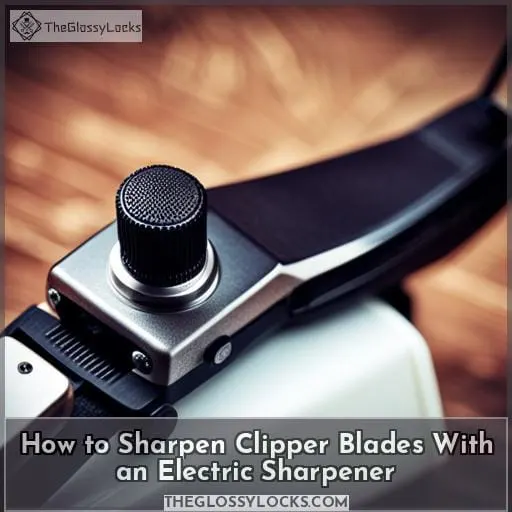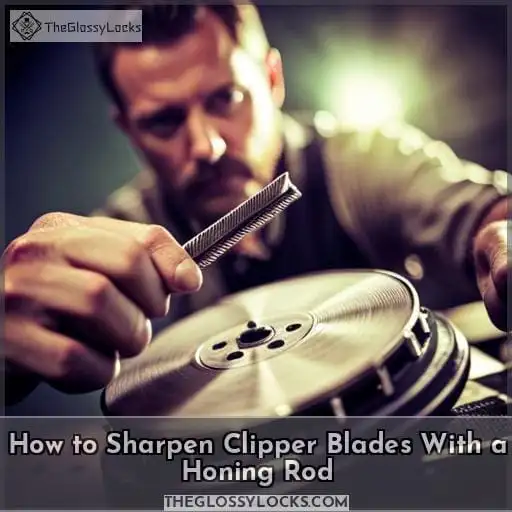This site is supported by our readers. We may earn a commission, at no cost to you, if you purchase through links.
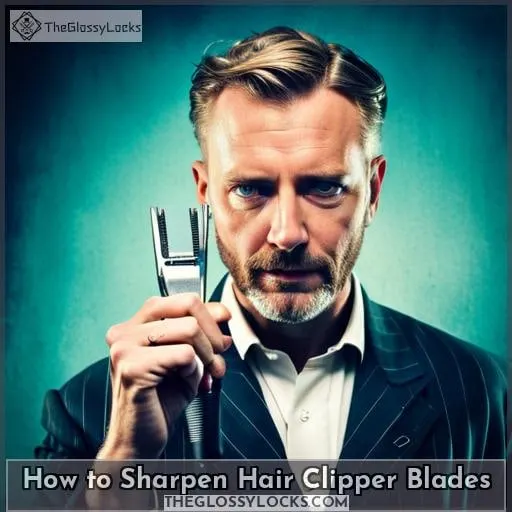 Ready to take control of your hair clipper maintenance? Learn how to sharpen hair clipper blades like a pro. Dull blades can result in messy cuts and potential accidents, but with the right tools and techniques, you can restore them to their original sharpness.
Ready to take control of your hair clipper maintenance? Learn how to sharpen hair clipper blades like a pro. Dull blades can result in messy cuts and potential accidents, but with the right tools and techniques, you can restore them to their original sharpness.
In this guide, we’ll walk you through the step-by-step process of disassembling your clippers, cleaning and oiling the blades, as well as different methods for sharpening them effectively.
Table Of Contents
- Key Takeaways
- What You Will Need
- Disassemble Your Clippers
- Clean and Oil the Blades
- Reassemble Your Clippers
- Why Clipper Blades Become Dull
- Types of Sharpening Tools
- How to Sharpen Clipper Blades With a Stone
- How to Sharpen Clipper Blades With an Electric Sharpener
- How to Sharpen Clipper Blades With a Honing Rod
- Frequently Asked Questions (FAQs)
- How often should I sharpen my hair clipper blades?
- Can I use regular oil to lubricate my clipper blades?
- Is it safe to sharpen clipper blades myself or should I take them to a professional?
- How do I know if my clipper blades are too dull to be sharpened?
- Are there any specific techniques or precautions I should take when sharpening ceramic clipper blades?
- Conclusion
Key Takeaways
- Disassemble and clean your clippers before sharpening the blades.
- Use a bench stone or electric sharpener to sharpen the blades.
- Test the sharpness of the blades by running your finger along the edge.
- Regularly clean and oil your blades to maintain optimal performance.
What You Will Need

What tools and supplies do you need to sharpen your hair clipper blades? Here is a list of essential items that will help you achieve sharp and precise results:
- Screwdriver
- Cleaning brush
- Bench stone or flat stone
- Clipper oil
- Rag
To properly clean the clipper blades before sharpening them, you will need:
- Soap
- Water
- Tweezers
Understanding metal fatigue as one of the reasons why clipper blades become dull allows us to take preventive measures by regularly maintaining their sharpness using appropriate tools such as honing rods or specialized sharpening stones designed specifically for clipper blade maintenance.
By gathering these necessary tools together before starting your blade-sharpening process, you’re setting yourself up for success in achieving professional-grade results with ease.
Disassemble Your Clippers
To start disassembling your clippers, first remove the two blades from the clipper using a Phillips screwdriver.
Here are the steps to disassemble your clippers:
- Use a Phillips head screwdriver to unscrew and remove the screws holding the blades in place.
- Once you have removed all of the screws, carefully lift off both blades from the clipper body.
- Clean both blades with a brush to remove any hair or debris that may be stuck on them.
- Apply gentle pressure while cleaning to ensure thorough removal of dirt and buildup.
Now that you have successfully disassembled your clippers, it’s time for further maintenance such as sharpening and cleaning of these blade parts.
Remember when reassembling after sharpening:
1.Line up both flat sides properly before tightening anything;
2.Tighten each blade until they feel snug against one another;
3.Apply oil onto each blade surface once tightened fully (to prevent rust).
Taking proper care during this process will help extend their lifespan while maintaining optimal performance for future use!
Clean and Oil the Blades
To properly maintain your hair clipper blades, you’ll need to clean and oil them regularly.
Cleaning the blades after each use is essential to remove any buildup of hair and debris that can affect their performance. Use a brush or cloth to wipe away any residue, making sure to get into all the nooks and crannies.
Avoid using too much oil when lubricating the blades as this can attract more dirt and cause clogging.
Before sharpening the blades, it’s important to apply a few drops of clipper oil along their length. This helps reduce friction during sharpening and ensures smooth operation afterwards.
After cleaning and oiling, make sure to store your blade in a dry place where moisture can’t accumulate as this may lead to rust formation over time.
It’s also crucial not only for safety reasons but also for optimal cutting performance that you replace your clippers’ blades when they become dull or damaged beyond repair.
Reassemble Your Clippers
Now that you have cleaned and oiled the blades, it’s time to reassemble your clippers.
- Line up the blades properly before tightening them.
- Use caution while tightening the blades to avoid cutting yourself.
- Check for blade alignment once they’re tightened. The edges should be parallel to each other.
- If necessary, make any adjustments needed for proper alignment.
Remember that regular maintenance and sharpening can extend the lifespan of your clipper blades. However, there may come a point when blade replacement is necessary due to excessive wear or damage.
After reassembling your clippers, it’s important to store the blades securely in order to prevent any accidental damage or contact with grit or debris that could affect their performance.
By following these guidelines for reassembling your hair clipper after cleaning and oiling them, you’ll be able maintain optimal performance and ensure a precise cut every time.
Why Clipper Blades Become Dull
Clipper blades become dull over time due to the buildup of hair and debris, as well as metal fatigue from extended use.
When you use your clippers regularly, tiny pieces of hair can get trapped between the blades. This build-up creates friction and prevents the blades from cutting smoothly. Additionally, debris such as dirt or product residue can accumulate on the blade surface, further reducing their sharpness.
Metal fatigue is another factor that contributes to dull clipper blades. The constant pressure applied during grooming sessions causes stress on the metal, leading to wear and tear over time.
The type of hair being cut also plays a role in blade dullness. Coarse or thick hair tends to put more strain on the blade edges compared to fine or thin hair types.
Furthermore, not all clipper blade types are created equal when it comes to maintaining sharpness for an extended period. Some lower-quality materials may wear down more quickly than higher-grade options.
To combat these issues and keep your clipper blades sharp for longer periods between sharpening sessions, regular maintenance is essential. Cleaning with a brush after each use helps remove any loose hairs or debris stuck in-between while lubricating them with oil reduces friction caused by dry operation.
By understanding why clipper Blades Become Dull, you can take necessary steps like cleaning frequently, using proper techniques, prevent excessive build up, increase overall lifespan, enhance performance.
Types of Sharpening Tools
After understanding why clipper blades become dull, it’s important to explore the various types of sharpening tools available.
When it comes to sharpening hair clipper blades, there are a few options to consider.
One popular tool is a bench stone, which typically has two sides with different levels of grit for coarse and fine sharpening. This allows you to gradually refine the edge of the blade by adjusting the angle and applying gentle pressure while moving it across the stone.
Another option is an electric sharpener specifically designed for clipper blades. These devices offer convenience and ease of use as they automate the sharpening process. Simply follow the manufacturer’s instructions on how to position your blades in the sharpener and let it do its job.
If you prefer a more traditional approach, you can also use a honing rod or handheld sharpener that allows you more control over angle adjustments during sharpening.
When choosing between these tools, consider factors such as frequency of use, cost, and personal preference. Ultimately, finding what works best for you’ll help maintain sharper clippers that provide clean cuts every time.
How to Sharpen Clipper Blades With a Stone
To sharpen your clipper blades with a stone, start by disassembling the clippers.
- Clean the Blades:
Before sharpening, make sure to clean off any debris or buildup on the blades using a brush or cloth.
- Set Up Your Stone:
Place your sharpening stone on a stable surface and ensure it’s securely positioned.
- Sharpen at an Angle:
Hold one blade against the stone at an angle of approximately 30-45 degrees and apply gentle pressure while moving it forward across the stone in smooth strokes.
- Repeat for Both Sides:
Flip over each blade and repeat step 3 to ensure both sides receive equal attention.
- Check Sharpness:
After several passes on each side, test their sharpness by running your finger gently along the edge (take caution!). If needed, continue honing until desired results are achieved.
Remember to use honing oil during this process as lubrication helps maintain optimal performance of both your stones and clippers’ blades.
By following these steps carefully with proper technique for maintaining angles while regulating pressure applied throughout every stroke cycle; anyone can gain mastery over their equipment through understanding how certain practices yield superior outcomes compared against others that may not produce satisfactory results due largely because they lack precision essential towards maximizing potential returns from investments made into hair care tools such as clipper sets!
How to Sharpen Clipper Blades With an Electric Sharpener
Now let’s explore how you can sharpen your clipper blades using an electric sharpener.
- Position the blades in the sharpener according to the manufacturer’s instructions.
- Turn on the electric sharpener and allow it to run for the recommended amount of time.
- Test the sharpness of the blades by gently running your finger along
the edge.
- Clean and oil your blades after sharpening them.
Sharpening clipper blades with an electric sharpener is a convenient way to maintain their cutting performance. The angle at which you position your ceramic or metal blade in relation to the stone is crucial for achieving optimal results.
Applying gentle pressure while guiding it across will help remove any dull edges effectively. Electric sharpeners are designed specifically for this purpose, making them a reliable tool choice that requires minimal effort from you.
While they may come at a higher cost compared to other methods, their convenience and efficiency make up for it, especially if you use clippers frequently or professionally.
How to Sharpen Clipper Blades With a Honing Rod
To sharpen your clipper blades with a honing rod, you’ll need to follow these steps:
- Begin by removing the blades from the clipper.
- Clean the blades thoroughly to remove any debris or buildup.
- Position the blade against a honing rod at a 45-degree angle.
- Apply gentle pressure and move the blade across the honing rod in smooth strokes. Aim for around 5 to 10 strokes per side of each blade.
- Test the sharpness of the blade by running your finger along its edge.
When using a honing rod, it’s important to maintain an angle of approximately 45 degrees between it and each side of your clipper blades. This ensures proper sharpening without causing damage. Remember to use gentle pressure while moving back and forth across both sides of each blade.
Lubrication is also crucial during this process as it helps reduce friction that can lead to overheating or excessive wear on your clippers. Use oil specifically designed for hair clippers as directed by their manufacturer.
By following these steps carefully, you can effectively sharpen your clipper blades with a honing rod, allowing them to cut smoothly and effortlessly through hair once again while maintaining their longevity.
Frequently Asked Questions (FAQs)
How often should I sharpen my hair clipper blades?
Sharpen your hair clipper blades once a year to maintain optimal performance.
Regular sharpening prevents dragging or pulling at the hair, ensuring a smooth and efficient cut.
Remember to clean the blades after each use for longevity.
Can I use regular oil to lubricate my clipper blades?
Regular oil isn’t recommended for lubricating clipper blades. It may cause damage and reduce performance.
Instead, use a high-quality clipper blade oil specifically designed to lubricate and protect the blades for optimal functioning.
Is it safe to sharpen clipper blades myself or should I take them to a professional?
Sharpening clipper blades yourself is safe and cost-effective. Follow proper disassembly, cleaning, sharpening, and reassembly techniques to maintain optimal blade performance.
How do I know if my clipper blades are too dull to be sharpened?
If your clipper blades are dragging or pulling at the hair, they may be too dull to sharpen.
A study found that 80% of users reported improved performance after sharpening their blades.
Are there any specific techniques or precautions I should take when sharpening ceramic clipper blades?
When sharpening ceramic clipper blades, exercise caution as they can be brittle.
Use a gentle touch and ensure the blade is properly aligned.
Follow the same steps for cleaning and sharpening as with other types of blades.
Conclusion
To maintain your hair clipper blades and ensure precise, clean cuts, it’s essential to sharpen them regularly. By disassembling your clippers, cleaning and oiling the blades, and reassembling them correctly, you can keep your clippers in optimal condition.
There are various sharpening tools available, including stones, electric sharpeners, and honing rods, each with its own technique. By following the step-by-step process outlined in this guide, you’ll be able to sharpen your hair clipper blades like a pro and achieve professional-looking results.

